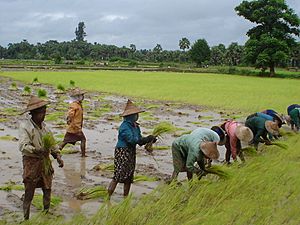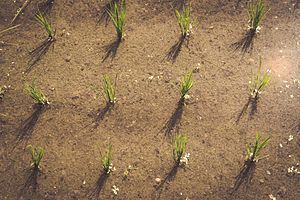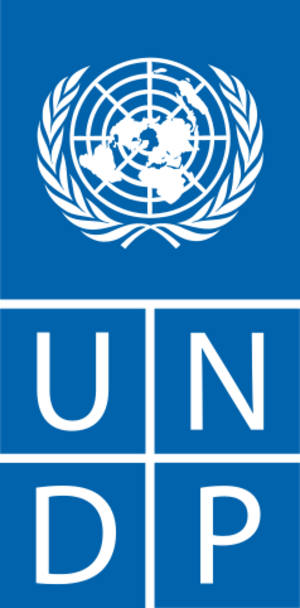Rice production in Myanmar facts for kids
Myanmar is one of the world's biggest rice producers, ranking seventh globally. About 43% of all farming in Myanmar is about growing rice. Out of all the land in Myanmar, a large part is used for growing rice. In 2019, Myanmar produced a huge amount of milled rice, which is rice ready to be eaten.
For a long time, Myanmar has been a major country for growing and selling rice. This is because it has good weather for rice fields and the government has helped farmers. Farmers often use traditional methods, especially during the rainy season. This has led to many different kinds of rice growing there. Lately, Myanmar has been working with international groups. These groups give money and new technology to help rice farmers.
Contents
A Look Back: Rice History in Myanmar
Rice has always been a very important food in Myanmar. It can grow almost anywhere in the country. When the British took control around 1824, they encouraged more rice farming to sell it. This made rice production grow a lot, especially near the Irrawaddy River. To sell more rice to Europe, the British helped people move to Lower Myanmar. This made sure there were enough workers, land, and money for rice farming. Because of this, 92% of the main rice-growing areas grew even bigger.
Right before World War II, Myanmar was the world's top rice producer. It sold rice to many countries in Asia and Europe. But after 1945, about half of the rice farms were left empty. This happened because many people moved from farms to cities. In the 1950s, the government stepped in to help. They passed a law called the Land Nationalization Act. This law gave farmers land security and loans. These actions helped rice production grow again. Also, countries affected by the war started growing their own food. This meant they didn't need to buy as much rice from Myanmar. Other countries, like Thailand, became strong competitors. They offered better quality rice and prices.
Later in the 1900s, new science helped rice farming a lot. Groups like the International Rice Research Institute (IRRI) also gave international help. Because of these efforts, rice production in Myanmar grew by more than 80% during this time.
Where Rice Grows: Myanmar's Geography
Myanmar's climate is perfect for growing rice. This makes rice farming the most important part of the country's economy. Rice production depends on the environment. So, there are different types like rain-fed lowland rice, deep-water rice, and irrigated rice. The monsoon season, which is the rainy season, is the main time for growing rice. Rice fields need a lot of water. Myanmar gets a lot of rain, from 800 mm to about 5,000 mm, during the monsoon season (May to October).
Most rice is grown in the delta regions of Ayeyarwady, Bago, and Yangon. These areas have big river systems. They make up a large part of the total rice farming land. However, drier and mountainous areas like Mandalay, Sagaing, and Magway also grow some rice. Coastal areas like Mon and Rakhine States also contribute.
During the monsoon season, the delta region produces the most rice. The dry zone, coastal areas, and mountainous regions also produce significant amounts.
How Rice is Produced
In Myanmar, rice farming mostly uses human and animal power. These are traditional ways of growing crops. The country has four types of soil that are great for rice: gleysols, fluvisols, humic planosols, and vertisols. Even with good soil, many things can make rice production difficult. These challenges have changed over time. Sometimes, government actions have caused problems. Other challenges include unpredictable weather, like floods. For example, floods in 2018 caused a 1.5% drop in rice production. Poor seed quality and not enough fertilizer also hurt production. A study found that high fertilizer prices, lack of irrigated water, and farmers' education levels were slowing down rice growth.
Farmers prepare the land differently depending on where the rice field is. In rain-fed lowlands, farmers usually plant rice by hand. They put young rice plants into partially submerged fields. This is called wet rice cultivation.
There are three ways wet rice cultivation happens:
- Plants stay partly underwater from natural rainfall during the monsoon season.
- Plants stay partly underwater from natural drainage or irrigation, plus natural rainfall.
- Plants grow near lakes that often flood.
For upland and deep-water rice farms, farmers often use direct seeding. This means they scatter or poke non-germinated seeds into dry soil. These seeds then grow into crops, which are sometimes moved during the monsoon season.
In the past, rice was usually grown only once a year during the monsoon season. Other crops were sometimes planted in the delta after the main rice harvest. Today, thanks to irrigation systems, rice can be grown all year long. During the monsoon season, rice crops need less help. They are usually planted around the end of November.
Types of Rice Grown
Myanmar has about 2,000 different types of rice! They can be grouped by when they are harvested:
- Pre-monsoon rice: This rice makes up about 2% of the total harvest area. It's planted with irrigation in March and harvested in July. You'll find this type in central Myanmar.
- Monsoon rice: This is the most common type, covering about 80% of rice fields. It's planted in mid-June, moved in mid-July, and harvested in mid-October. This rice grows all over the country.
- Late monsoon rice: This type is also about 2% of the harvest area. It's planted in August, moved in September, and harvested in January. It grows in low-lying areas of the delta.
- Mayin rice (or winter rice): This rice covers about 15% of the total harvest area. It's planted in November, moved a month later, and harvested in March. It's often grown along river valleys.
Selling and Trading Rice
| Year | Production (in '000 tonnes) | Exports (in '000 tonnes) |
|---|---|---|
| 2014/2015 |
12,600
|
1,734
|
| 2015/2016 |
12,200
|
1,800
|
| 2016/2017 |
12,500
|
1,600
|
For many years, the government of Myanmar has been very involved in helping rice production. Since 1989, a group called the State Law and Order Restoration Council (SLORC) allowed private companies to buy and sell rice. This happened because in 1988, the country's economy was struggling with grain exports. The SLORC also offered other ways to help the rice export business grow:
- Giving out farming loans.
- Lowering taxes on imports to encourage buying important farming tools.
- Holding workshops and talks to help people learn business skills.
- Encouraging farmers to save money by opening new bank branches.
In 1995, Myanmar joined the World Trade Organization (WTO). Two years later, it joined the Association of Southeast Asian Nations (ASEAN). The government started using policies that were more open to the global market. This meant the government gave up some control over farming and selling rice. This helped Myanmar build stronger relationships with other countries that bought its rice, especially other ASEAN members.
Export by type of rice, 2016-17 White long grain (42.83%) White short grain (31.66%) Parboiled rice (0.94%) Glutinous rice (0.14%) Other rice (0.01%) Broken rice (24.42%)
As Myanmar became a more democratic government, it made new rules for the rice industry. In 2012, new laws allowed farmers to transfer or use their land rights as collateral for loans. Also, the tax on rice exports was lowered to 2%. This helped private companies get more involved in buying and processing rice. The Myanmar Rice Federation (MRF) was also created in the same year.
Thanks to the SLORC's efforts, rice exports reached 1.8 million tons in 2015/16. China was the biggest buyer. The governments of China and Myanmar signed an agreement. This allowed Myanmar to export 400,000 metric tons of rice to China. This agreement was important because a lot of rice was being smuggled, which hurt official exports. China also agreed to fight against smuggling.
| Destination | Percentage of rice export | ||
|---|---|---|---|
| 2012/2013 | 2013/2014 | 2014/2015 | |
| EU | 5.4 | 5.7 | 11.1 |
| ASEAN | 18.2 | 11.8 | 5.4 |
| (ASEAN) + 3 | 53.6 | 73.8 | 76.1 |
| Middle East | 0.7 | 0.7 | 1.8 |
| Africa | 14.2 | 0.2 | 0.2 |
| Other | 7.9 | 7.9 | 5.4 |
Today, most of Myanmar's rice exports are white long grain, white short grain, and white broken rice. These are mainly sent to China and other ASEAN countries.
Working Together: International Help
The Myanmar Agricultural Development Bank (MADB) gives loans to farmers each season. In 2018, these loans were worth about US $1.12 billion. Farmers can get a loan for up to 10 acres of land, with an 8% interest rate. But Myanmar isn't the only one helping its farmers. Other countries also offer big loans to support farming. For example, the Japan International Cooperation Agency (JICA) offers a four-year loan program. This program works with both the Japanese and Myanmar governments.
The International Rice Research Institute (IRRI) in the Philippines has offered more than just money. They have made scientific breakthroughs in rice farming. They have created new types of rice that grow faster and produce more. They also teach farmers modern farming methods. This has helped farmers get bigger and faster harvests.
Other international groups, like the United Nations Development Programme (UNDP), the World Bank, and the Asian Development Bank, also help Myanmar with its development plans. The UNDP, for example, collects information and writes reports with the government. This helps them create new policies and give aid. In 2015, the UNDP and IRRI worked together to give seeds to rice farmers in Rakhine State who were affected by floods.
In late 2013, Myanmar's government officials, including the Minister for Agriculture, talked with IRRI. They wanted to build a stronger partnership for rice research. The next year, the government focused on educating farmers. They held meetings where farmers learned new harvesting technologies. This helped reduce how much rice was lost. In 2015, the government and IRRI teamed up to create the Myanmar Rice Sector Development Strategy (MRSDS). They hoped this would help Myanmar become a major player in the global rice market again. Finally, in 2016, these partnerships led to Myanmar's government releasing a 12-step economic plan. One of its main goals was to support groups of farmers who grow crops, raise animals, and catch fish.





